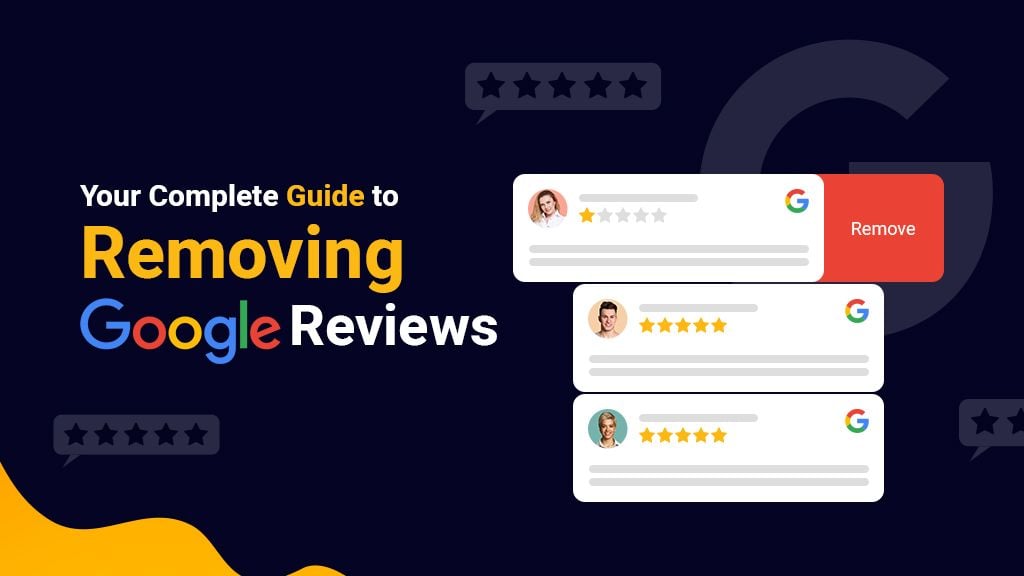Your Complete Guide to Removing Google Reviews
)
We've all been there. You're doing your best, your customers are happy, and suddenly, a rogue review pops up on Google. Maybe it’s a blatant spam comment, a misunderstanding, or a review that’s plain unfair. Whatever the case, you deserve an online reputation that accurately reflects your business.
But here’s the good news: not all reviews are not always set in stone. If a review is offensive, spammy, or violates Google’s policies, you’ve got options for removal. And if it’s a genuine piece of feedback that’s just a bit rough around the edges, responding professionally can turn a challenging review into a chance to shine.
In this guide, we’ll take you step-by-step through removing unwanted Google reviews, from flagging policy-breaking comments to making the most of constructive feedback.
By staying proactive with your reviews, you’ll be ready to handle any feedback that comes your way ensuring that potential customers see the best, most authentic version of your business.
Why Removing Certain Google Reviews Matters
Not every review should stay on your Google Business Profile. While authentic feedback (even if it’s negative) offers a chance to improve and build credibility, there are instances where removal is necessary. Removing a problematic review can protect your brand’s reputation and ensure your potential customers see a more accurate picture of your business. But, it’s essential to know when a review truly warrants removal.
When Should You Remove a Google Review?
First things first, understand Google’s policies.
Here's a quick rundown of reviews that typically violate Google’s guidelines:
- Spam and Fake Content - Fake accounts, promotional content, or repetitive posts from the same person can all fall under spam.
- Offensive Language - Reviews with inappropriate language or personal attacks can be removed.
- Off-Topic or Irrelevant Content - If the review has nothing to do with your business (e.g., it’s about another location or a completely different product), it may be removed.
- Conflicts of Interest - Reviews posted by employees or former employees, or competitors trying to harm your business, violate Google’s policies.
- Illegal Content or Threats - Any reviews that include illegal content, threats, or hate speech are not permitted on Google.
Being aware of these guidelines is your first step to understanding if removal is possible. If you’re certain a review violates these standards, here’s how to act.
Step-by-Step Guide to Flagging a Google Review
Flagging a review is Google’s preferred way for users to report inappropriate or non-compliant content. Follow these steps:
1. Access Google Business Profile
- Start by signing in to your Google Business Profile. This is where all your reviews are managed and where you’ll have the option to report a problem.
2. Locate and Select the Review
- Once logged in, navigate to the specific review you wish to flag. Click on the three vertical dots on the right side of the review.
3. Choose “Flag as Inappropriate”
- A dropdown menu will appear; select “Flag as inappropriate.” Google will then ask you to specify the issue with the review.
4. Explain the Violation
- Provide a brief explanation of why the review violates Google’s guidelines. Focus on the specific issue rather than lengthy details; this improves your chances of a prompt and successful review by Google.
5. Monitor for Google’s Response
- After flagging a review, it typically takes a few days for Google to respond. If they determine the review violates policies, they will remove it from your profile. This process may vary in speed, but checking in every few days helps keep track.
When Flagging Isn’t Enough: Contacting Google Support
In some cases, flagging a review won’t lead to its removal, especially if Google doesn’t recognise the violation immediately. If you believe strongly that the review breaks the guidelines, the next step is to contact Google Support directly. Here’s how:
1. Open Google Support Options
While logged in to your Google Business Profile, click on the “Support” section, which is usually in the bottom left of your dashboard. Here, you’ll find a range of support options.
2. Select Your Preferred Method of Contact
- Depending on your preference and availability, Google provides multiple ways to reach out; email, chat, or phone support. Select whichever option is most convenient.
3. Be Prepared with Evidence
- In your message or call, be clear about the policy violation, and if possible, provide screenshots or examples. Evidence will help speed up the process, as it gives the Google support team a clearer idea of the issue.
Responding to Genuine Negative Reviews
While flagged or flagged-and-supported reviews may get removed if they break the rules, sometimes a negative review doesn’t violate Google’s guidelines. In this case, responding professionally can be your best tool.
Here’s how to respond in a way that strengthens rather than damages your business reputation:
- Respond Quickly: Timely responses show your customers that you care. Aim to respond within a few days, or ideally sooner.
- Acknowledge the Issue: Even if you disagree, showing empathy and acknowledging the customer’s experience goes a long way.
- Offer a Solution: If there’s a genuine issue, try to offer a resolution publicly. If further discussion is needed, encourage them to continue the conversation privately.
- Stay Positive: Remaining calm and constructive reflects well on your brand and reassures potential customers reading the review.
Frequently Asked Questions About Google Reviews
How long does it take for Google to remove a review?
After you’ve flagged a review, Google generally takes a few business days to assess and respond. However, the exact timeframe can vary based on factors such as volume and the complexity of the case.
Can a review reappear after it’s been removed?
In rare cases, reviews may be reinstated if the user appeals or if Google revisits the decision. If this happens, you can flag the review again or contact support to clarify the situation.
What if a customer posts a negative review after a dispute?
It’s possible that an unhappy customer may leave a review after a negative interaction, such as a refund dispute. While frustrating, it’s typically best to address it professionally rather than seek removal unless it clearly violates Google’s guidelines.
Practical Tips for Managing Google Reviews
Beyond just removing negative reviews, proactively managing your Google reviews can give you an edge. Here’s how to stay on top of it:
- Regularly Monitor Your Reviews: Make it a habit to check your reviews weekly. This keeps you aware of what’s being said and allows you to respond quickly.
- Encourage Positive Reviews: While it’s against Google’s guidelines to ask for reviews in bulk or offer incentives, politely encouraging satisfied customers to leave a review can help maintain a balanced rating.
- Track Recurring Issues: If multiple customers mention the same problem, it’s a sign that something in your business might need attention. Use feedback constructively to improve.
- Use Review Management Tools: Several tools can help you monitor and manage reviews effectively. Google offers some built-in features, and there are also third-party tools like BrightLocal and Podium that can integrate with your profile.
Building a Strong Reputation Beyond Reviews
A great Google review strategy doesn’t just focus on deleting unwanted content but also on building a positive brand image. Every interaction with a customer is a chance to influence how they see your business and, ultimately, what they say about you online.
Respond Positively to All Feedback
Responding positively to all reviews, whether they’re glowing or critical, shows that you value customer experiences and care about maintaining high standards. Google will reward you for responding as well.
Showcase Reviews on Your Website
Displaying positive Google reviews on your website not only boosts credibility but also gives prospective customers confidence in your business.
Encourage Offline Feedback Too
Engaging customers to provide feedback directly to you before they post online can help manage and resolve issues before they reach public platforms.
Key Takeaways
Removing unwanted Google reviews isn’t just about keeping your rating high. It’s about creating a trustworthy online presence that reflects your business’s true values. Here’s what to remember:
- Know the Rules: Be clear on what types of reviews violate Google’s guidelines. This is essential for effective review management.
- Flag Appropriately: Follow Google’s process for reporting non-compliant reviews, but have patience. It may take time.
- Respond Professionally: Sometimes, responding well to a negative review is the best approach. It’s a powerful way to show future customers that you’re responsive and dedicated to improvement.
Being proactive with review management can enhance your brand’s online image and keep customers confident in your business. By knowing when to act—and when to engage—you’re building a solid foundation for your online reputation.
If you are looking for a leveraged way to encourage more reviews, manage the process and display them on your website - talk to us about the AutoPilot Genie - it will save you time and make review management so much easier (and as an added bonus there are so many other elements this tool helps you do (including social media and GBP posting)
) Author:Tracey Voyce
Author:Tracey Voyce| Tags:NewsPromotionsSearch Engine Optimisation |
Check Out Our
Recent Articles
- Google's AI Mode is Here for Search Results: What Small Businesses Need t...
- 2025 Top Australian Business Directories to Boost Your Visibility
- The Power of Online Reviews: What the Latest Data Means for Your Business
- Why Blog Length Matters: Striking the Perfect Balance for Your Content
- Top Marketing Strategies for 2025



